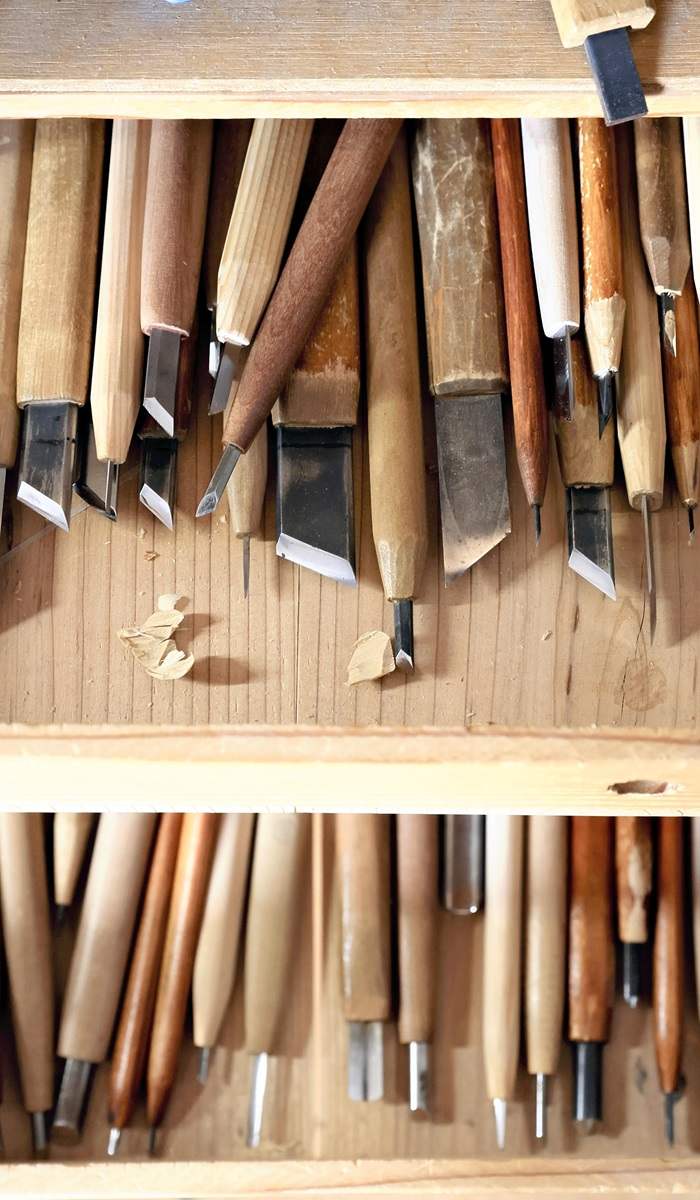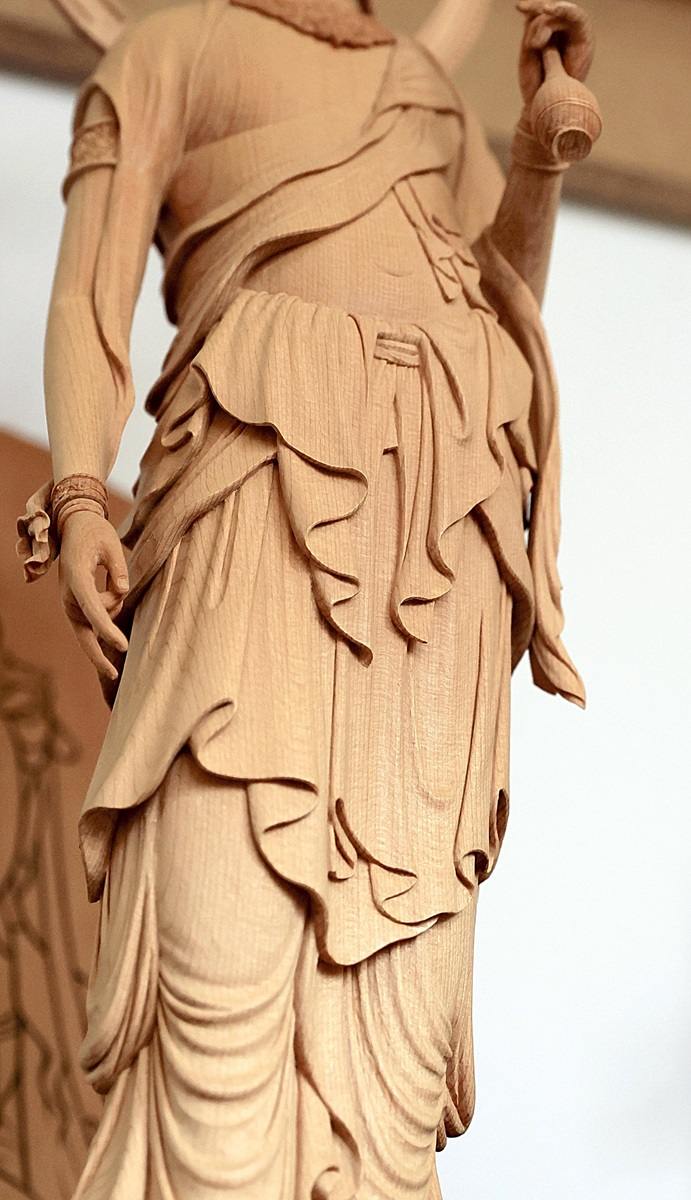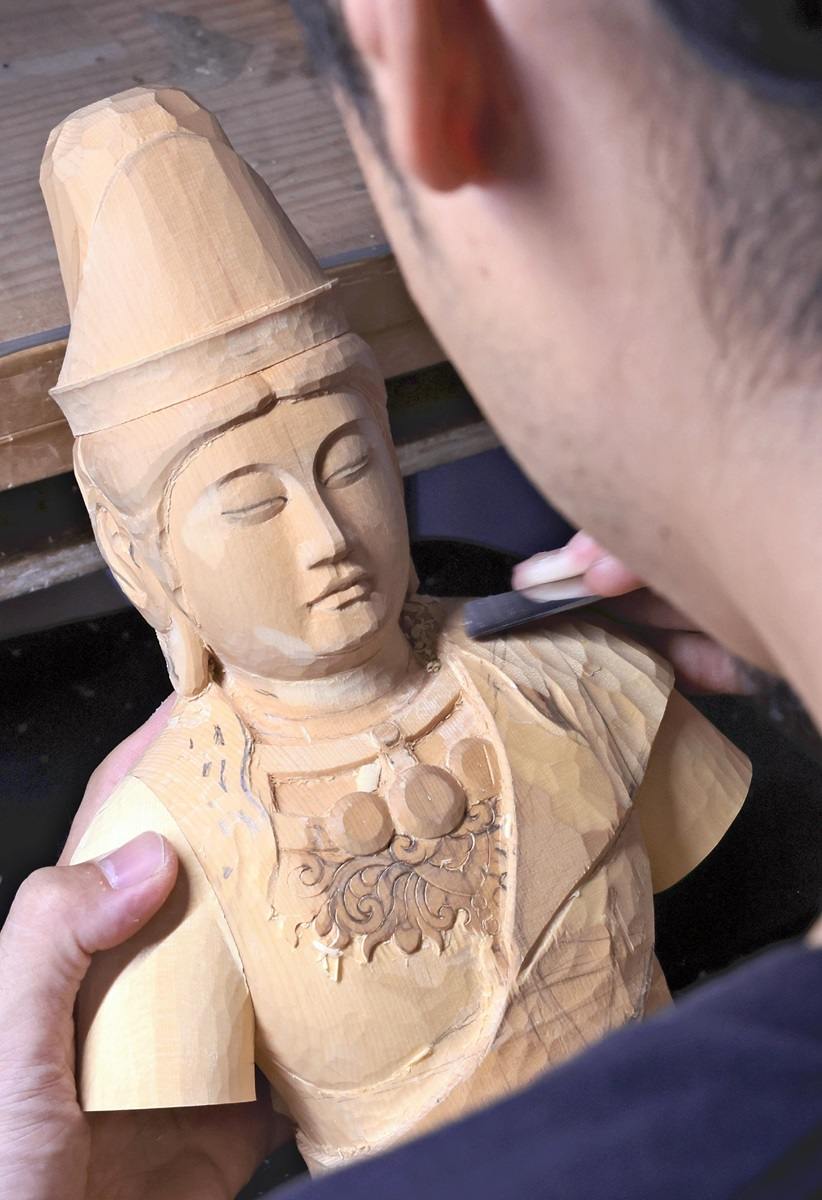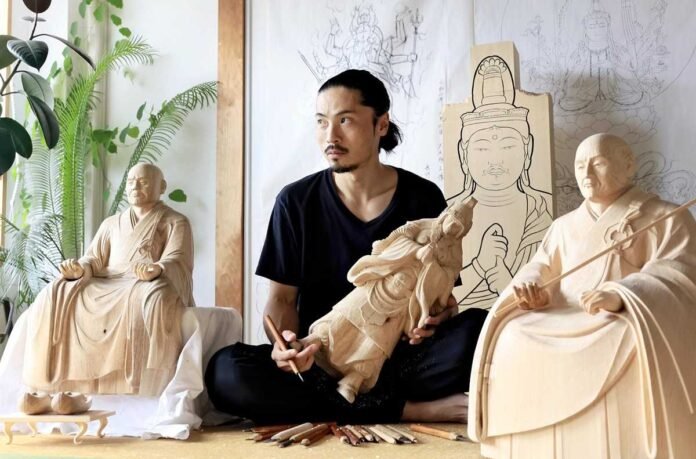Buddhist sculptor Gakyu Miyamoto holds a statue of Idaten he is working on in his studio in Minami Ward, Kyoto.

10:18 JST, November 2, 2024
KYOTO – One day in late September, after the scorching heat of summer had subsided, as evening approached and the crickets stopped buzzing, the sound of hand-carved wood rang out in an otherwise quiet workshop in Kyoto’s Minami Ward.
Cracking, cracking, cracking…
Gakyu Miyamoto sat inside on a tatami mat and made a statue of the Buddhist patron god Idaten. He occasionally blew on the surface, causing wood shavings to flutter away and reveal the robe of the wooden statue, which gradually took on a cloth-like texture.
Miyamoto plunged from the fashion world into the profession of Buddhist sculptor. That is why his powers are fully manifested in cutting clothes and accessories. When he goes to cut clothes on a statue, he folds a real piece of cloth and faithfully recreates the curtains on the statue. He also designs the accessories for each statue himself, sometimes incorporating motifs from Western art styles such as Art Nouveau.
The style of Miyamoto’s work has earned him a good reputation, and he has received many work orders from famous temples and shrines, including repairing the standing statue of Amida Nyorai (Amitabha) at Kiyomizu Temple and creating statues of shishi and komainu (lions). and guard dogs) for Shimogamo Shrine.

A wide variety of carving knives that Miyamoto uses
He also has many fans. On the social media platform He has over 70,000 followers on his social media accounts.
He currently has a list of about 100 projects to complete, with completion dates stretching to the year 2041.
He works hard every day, with the goal of creating “Reiwa-era images” of the kind that only I can create.
Gears fit perfectly
Miyamoto was born in Fushimi Ward, Kyoto, not far from his current workplace. As a child, he lost track of time by drawing on the blank backs of flyers when crayons were available. When he was in high school, he became interested in fashion and longed to become a fashion designer.
After graduating from high school, he studied dressmaking at a junior college in Kyoto and then attended a vocational school in Tokyo on a scholarship.
However, he was so confident in his talent that he was not satisfied with his studies at the school. He graduated without barely being there. After returning to his hometown, he lived in a cheap apartment without a bathtub and worked part-time to earn a living while trying to become a professional painter.
About six months later, when he began to worry about whether this was the right way to live, his older brother suggested he help a Buddhist sculptor. The sculptor was known to his brother and was looking for someone who could paint well.
Miyamoto visited the sculptor’s workshop near Kiyomizu Temple and was tasked with coloring a Buddhist statue. Although it was new to him, he was immediately fascinated by the work.
“Fashion items are consumed one after another, but Buddhist statues last for centuries. Are [the artists] thinking about the time after their death while doing their job? Miyamoto thought so and was overwhelmed by the scale of the work.
While helping out in the workshop, Miyamoto noticed that making Buddhist statues has a lot in common with tailoring. The knowledge of fabric textures and human anatomy he gained from tailoring came in handy when making sculptures.

While Miyamoto studied dressmaking, he is very careful about draping clothes on his sculptures.
“The gears of my life fit perfectly into place and started turning,” he said. He gave up his part-time job and officially apprenticed with the sculptor at the age of 25.
From then on, Miyamoto made Buddhist statues almost every day, from early morning to late at night. He felt like he had to work three or four times harder than other people because he started too late. After nine years of training, he became independent in 2015 and took the sculptor’s name ‘Gakyu’.
Gakyu consists of two Chinese characters that mean ‘self’ and ‘rest’. He chose the name out of self-discipline because his teacher had often said to him, “Your fault is that you are strong-willed.”
Universal beauty
At first, Miyamoto did not receive any work orders. But after he started showing his creations at exhibitions, he started getting jobs. His work became popular on social media sites, leading to an increase in orders.
He is currently working on 30 different images simultaneously.
His emotions and physical condition influence his work. His cheerful mood gives impact to his images and even inspires their terrifying facial expressions. Working in parallel on images of completely different types with completely different characteristics, he adjusts himself by sitting in meditation and centering himself, and then works on the image that best suits his condition.
To create his beautiful Buddhist statues, Miyamoto studies sculptures made not only in Japan but also abroad. To give his work a sense of modernity, he sometimes incorporates elements borrowed from show business celebrities into his images. He also does his best to learn about the aesthetics of the time through the responses to his work on social media sites.

Miyamoto’s carving progresses as he works with the wood.
He also experienced setbacks in his pursuit of universal beauty.
When he saw the seated statue of Miroku Bosatsu (Maitreya) at an exhibition, he was intimidated by its transcendent divinity. The statue of Daigo Temple in Kyoto is the work of Kaikei, a famous sculptor from the 12th-13th centuries. He said he thought, “I will never be able to reach this level.”
However, what intimidated him quickly became his new target.
“At some point before I leave this world, I want to carve a supreme Buddha statue of unchanging beauty.”
Driven by ambition, his chisel breathes life into his sculptures for a thousand years.
***
If you are interested in the original Japanese version of this story, click here.



